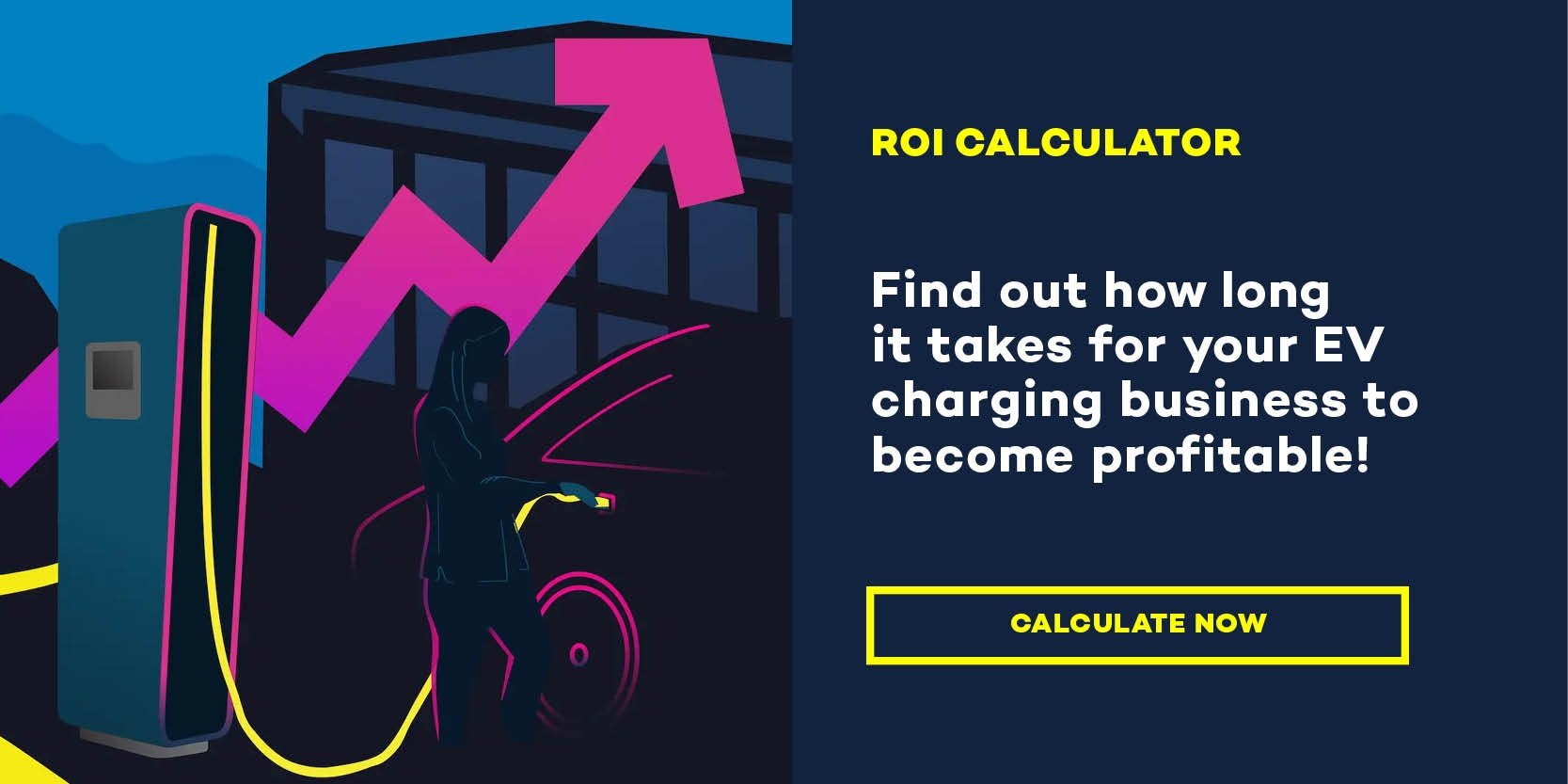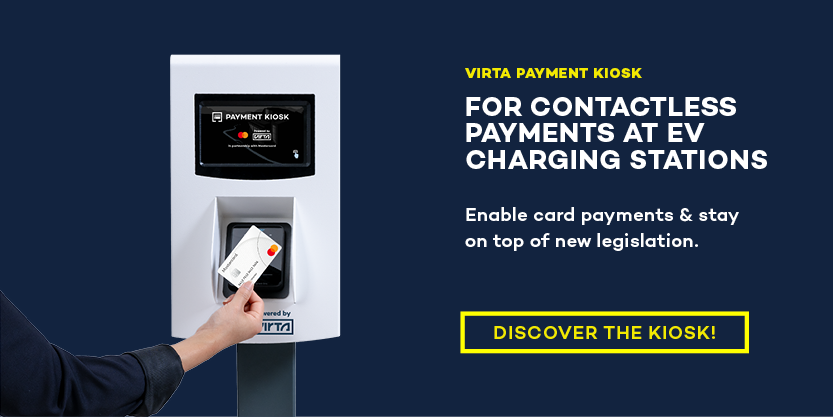GUIDE TO FAST DC CHARGING
- Introduction
- Chapter 1: Pros & cons of fast chargers
- Chapter 2: How do fast EV chargers work?
- Chapter 3: The structure of a fast DC charger
- Chapter 4: How do fast EV chargers differ?
- Chapter 5: How to select the ideal location
- Chapter 6: How do I choose the right DC charging station?
- Chapter 7: Costs
- Chapter 8: The installation process
- Chapter 9: AFIR and other regulations affecting fast EV charging
- Chapter 10: Operation, maintenance & EV driver services
- Chapter 11: What does the future hold?
- Chapter 12: Virta charging solutions for fast EV charging
Introduction
Fast electric vehicle (EV) charging possibilities must become a standard if we want EVs to finally make the leap into our everyday lives.
With DC charging stations or simply fast charging stations, EV batteries are charged in a much shorter time than with standard AC chargers, making the charging experience almost as convenient as filling up your car at a petrol station.
This type of EV charging will be the deciding factor for many consumers in switching from an ICE to an EV.
While charging can take up to several hours with standard AC charging stations with outputs of up to 22 kW, DC charging with a CCS or CHAdeMO plug opens completely new doors. Fast charging includes direct current (DC) charging from 22 kW charging power up. Everything from 150 kW up to 600 kW of charging power is called ultrafast or high-power charging (HPC).
Installing a fast charging station makes sense in places where people take a short break and want their cars to be charged as quickly as possible. These include retail stores, airports, petrol stations, public and private parking facilities, tourist destinations, and more.
But fast charging stations are not only a basic prerequisite for the spread of e-mobility, they also play an important role in other sectors:
- Heavy-duty sector: Fast charging stations are absolutely necessary in the logistics, construction, long-haul and public transport sectors, just to mention a few. Heavy-duty commercial vehicles like electric trucks or buses and their large batteries depend on fast charging possibilities.
- Fleets: Companies that manage large fleet of vehicles, from car sharing and rental car companies to taxi companies, rely on fast charging to have their vehicles charged and ready to go after only a short charging break.
From 0 to 100 in no time
More and more EVs roam our roads daily, and many rely on a public charging network that should be extensive and mainly reliable.
This is why the future of e-mobility lies in the hands of DC charging stations. In the next few years, the fast public charging network must expand noticeably to keep up with the increasing demand for EV charging.
This guide provides insights into DC charging and talks about various topics, from areas of application to selecting the best location and charging hardware. We will dive into DC charging stations’ costs, technical requirements, installation, legal framework, operation and maintenance.
Pros & cons of fast chargers
Pros
Fast charging stations offer numerous advantages. While AC charging takes several hours and, therefore, only allows a few charging sessions per day, fast charging stations are able to fully charge vehicle batteries in 30 minutes thanks to their high charging capacity.
This enables higher turnover and ensures significantly faster amortisation. The advantages of fast charging stations at a glance:
- Short charging times
- Higher charging capacities
- Modular design
- Faster amortisation
Cons
They also require additional electrical installations on site. The disadvantages of fast charging stations at a glance:
- Expensive to purchase
- Grid connection required
- Not all electric cars support high charging capacities
How do fast EV chargers work?
First things first
To start off, let's lay down a little bit of basic theory. When electricity leaves the charger, it is in an Alternate Current (AC) format. To be of any use to the EV, it needs to be in a Direct Current (DC)format.
A standard charging station (up to 22 kW) supplies an EV with AC electricity, which is then converted to DC inside the vehicle by an onboard charger.
What a fast charging station (22 kW and up) does is it skips over this step by already supplying the EV with DC electricity from the get-go. This leads to higher efficiency and faster charging times, because the conversion takes place inside the charging station itself.
As a result, EVs can charge for 100 kilometres of range in just a few minutes at fast chargers.
What happens during a charging session?
A DC charging station and the connected vehicle are in constant communication. The charging station optimises charging throughout and adjusts the charging power if necessary. If several vehicles are connected to a DC charging station simultaneously, the charging station distributes the available power to all the connected vehicles.
Depending on the vehicle model, priorities or rules can be set, such as a ‚first come, first serve‘ principle. The power electronics in the charging station ensure that it never supplies the EV with a higher charging speed than it can handle.
| Example: A VW ID.3 with a 77 kWh battery can have a maximum charging capacity of 125 kW. A 300 kW Alpitronic Hypercharger automatically supplies it with a maximum of 125 kW. |
At the beginning of the charging process, the charging power can be higher until the battery warms up, and then it decreases continuously to prevent overloading or overheating. Towards the end, when the charged level is around 80%, the charging power is significantly reduced to a minimum. This protects the battery and maximises its life.
Due to higher power requirements, the station’s structure is much more complex, directly impacting its dimensions.
| 💡 In winter, charging times are significantly longer due to lower ambient temperatures and a correspondingly colder battery. |
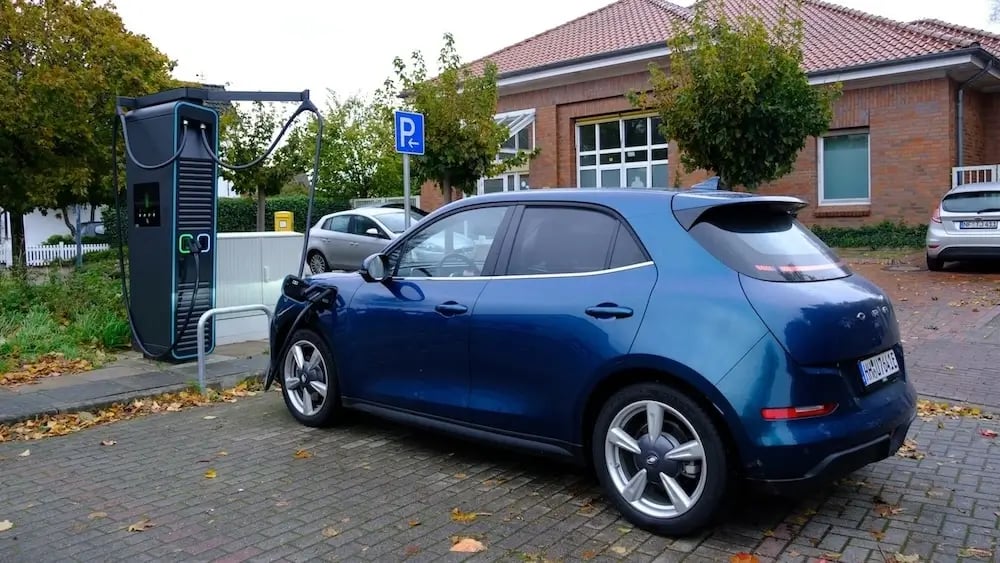
The structure of a fast DC charger
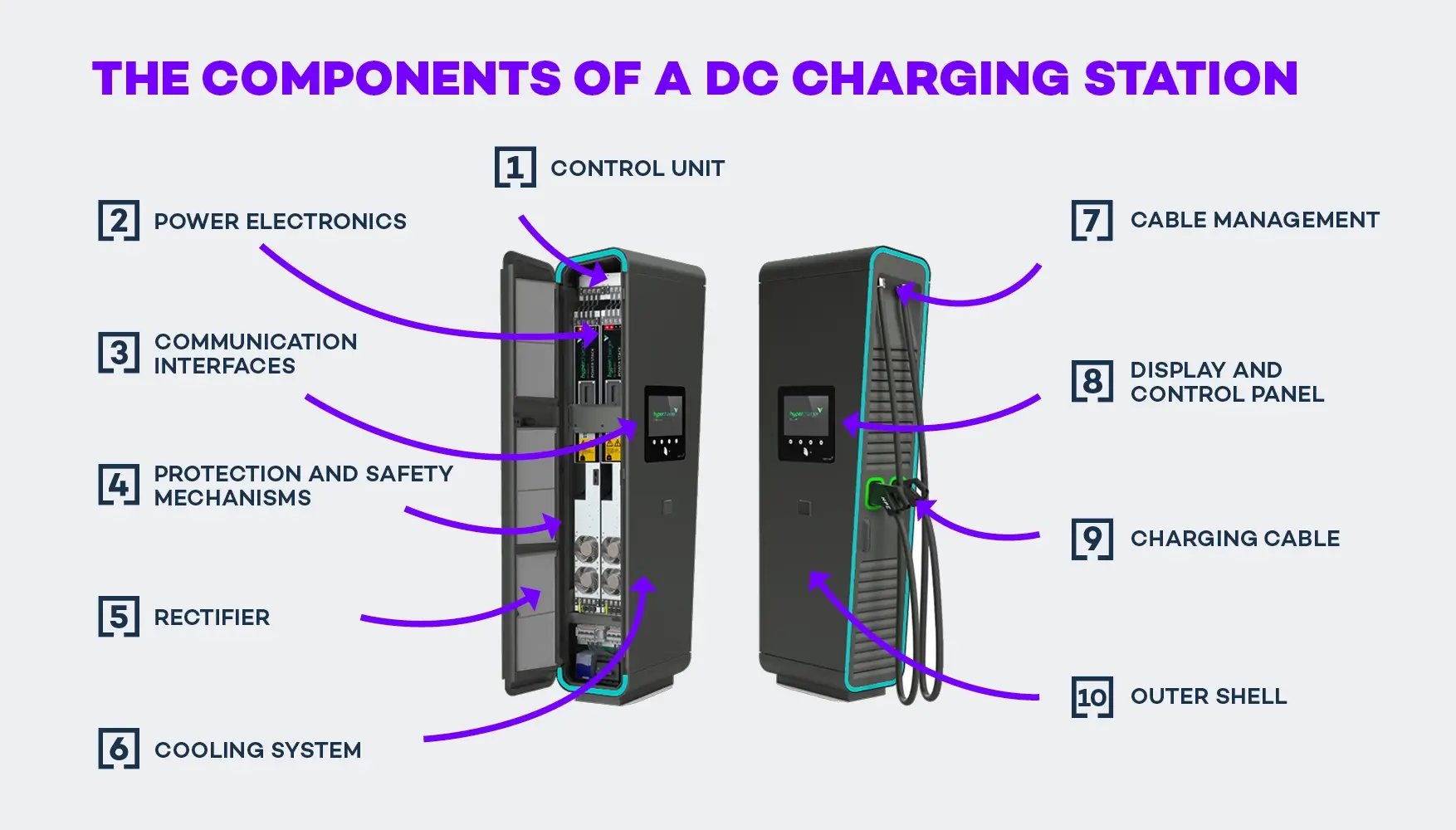
1. Control unit:
The brain of the DC charging station takes over the monitoring and control of the entire charging process. It controls the rectifier and the power electronics, communicates with the electric vehicle and ensures that the charging process occurs properly.
2. Power electronics:
Power electronics regulate and control the flow of electricity from the DC charging station to the electric vehicle, ensuring efficient charging.
3. Communication interfaces:
These interfaces enable the electric vehicle to communicate with the charging station. Information such as the charging status, the current charging power and billing information are exchanged.
4. Protection and safety mechanisms:
Various protection and safety mechanisms and devices ensure safe operation: overcurrent, overvoltage and overheating protection and a Residual Current Device (RCD).
5. Rectifier:
This is the central element of the DC charging station, which converts the alternate current (AC) from the power grid into direct current (DC).
6. Cooling system:
Due to the high power that flows during fast charging, the electronic components of the DC charging station generate heat. A cooling system keeps temperatures at an acceptable level.
7. Cable management:
Cable length and special areas of application, such as charging electric trucks and buses, often make cable management necessary. This is also available for standard DC charging stations.
8. Display and control panel:
A control panel with a display provides information on the current charging status, charging power and remaining charging time. EV drivers can start and stop charging and adjust other settings.
9. Charging cable:
DC charging stations have at least two connectors: CSS plugs (European standard), CHAdeMO plugs (Japanese standard), or a combination of both. From a current strength of 500A, charging cables usually have integrated cooling systems. Some models may also be equipped with an AC charging point.
10. Outer shell:
It protects the technology from external influences, takes on a crucial fire protection function, and can be provided with personalised foiling and branding.
How do fast EV chargers differ?
Nowadays, the market offers a large selection of different fast charging stations. Some examples of well-known DC charger manufacturers are Alpitronic, Kempower, Siemens, ABB, Schneider Electric, Tritium, Delta Electronics. And the list could go on.
Fast charging stations vary in terms of available charging power, the type of plug and their structure.
Charging power
The term 'fast charging' is an umbrella term for all DC charging from 22 kW and up. Inside that spectrum, we can find ultra fast charging (sometimes called high power charging (HPC) or rapid charging). This encompasses all charging from 150 kW up to 600 kW.
Fast charging stations are available from a power of 50 kW. Most models offer charging power at intervals of 100 kilowatts, i.e. 100 kW, 200 kW, 300 kW and 400 kW.
Ultra-fast chargers with higher charging capacities of up to 600 kW are currently also available on the market. And not to stop there, the first prototypes for megawatt charging (MCS, Megawatt Charging System) specifically developed to charge heavy-duty EVs have also been officially introduced.
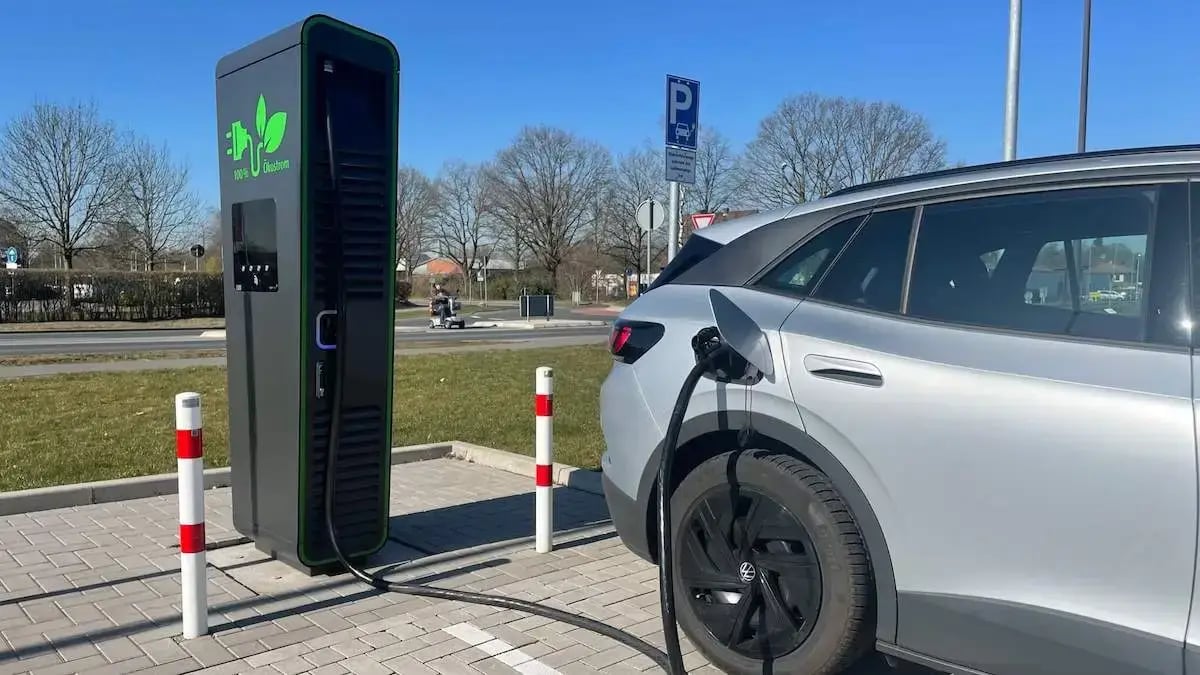
Type of plug
Most fast charging stations (excluding Tesla Supercharger) have at least two connections, either CSS plug (European standard), CHAdeMO connectors (Japanese standard) or a combination of both. Usually, several vehicles can charge at a fast charging station at the same time.
With CSS plugs, a vehicle battery can be supplied with up to 350 kW. Currents from 500 A require a so-called liquid-cooled cable.
CHAdeMO is the preferred charging technology of Asian car manufacturers. A CHAdeMO plug is intended for a charging power of 50 kW. Higher powers of 100 kW and 200 kW are also possible.
Often, DC fast charging stations also have an optional AC charging point with 22 kW.
Structure
Depending on the model and manufacturer, fast charging stations may have fundamental differences in a way their structure is built.
While most fast charging stations are built free-standing, some models can also be mounted on walls, such as the Alpitronic Hypercharger HYC 50.
Systems such as the Kempower Satellite make it possible to build the charging port separately from the power electronics. This makes the most sense if there is little space available at the location.
Fast charging stations from Alpitronic and Kempower have a modular design and can be subsequently expanded. Alpitronic Hyperchargers can be retrofitted at any time with additional "powerstacks" of 100 kW each. This is efficient and at the same time makes the hardware future-proof.
Cable length and cable management are also of particular importance. Specific areas of application, such as the loading of trucks and buses, often make additional cable management necessary.
Read also:
How to select the ideal location
DC charging is perfect for high traffic locations: along highways, at service and petrol stations.
Sites where drivers spend about 30 to 60 minutes, like supermarkets and shopping centres, are also suitable for DC chargers.
DC charging stations should be accessible to all vehicles and have sufficient space for parking, ideally allowing for charging around the clock.
- High traffic density: Perfect near frequented roads and highways.
- Proximity to metropolitan areas: Often, there is a high concen- tration of EVs and few oppor- tunities for private charging.
- Distance to other DC charging stations: There shouldn’t be a high con- centration of DC chargers around, but also not a too signif- icant distance between them
- Future security: Make sure your choice of lo- cation will still be attractive in the coming year
- Existing electrical connection: A sufficient electrical capacity in your location will save you extra effort and costs.
How do I choose the right DC charging station?
Once you find the ideal location for your DC charging station, the next step is to choose the proper hardware. The market for charging hardware has grown significantly in recent years to a wide range of products.
Well-known manufacturers of DC charging stations include Alpitronic, Kempower, Siemens, ABB, Schneider Electric, Tritium, Delta Electronics and many more.
DC charging stations are offered with a wide range of charging capacities and features.
The specific use case at the core
When choosing the right DC charging station, future charging point operators (CPO) take a closer look at the location and use case:
If you expect high traffic volume and high utilisation, the charging station of your choice should provide correspondingly higher charging power. It‘s important to remember that not all electric cars can handle outputs of over 150 kW. However, since DC charging stations usually have at least two charging ports, higher performance means that several electric vehicles can be charged simultaneously.
For example, a DC charging station with 300 kW and two charging points can supply two connected vehicles with 150 kW each simultaneously.
Modularity is key
Many DC charging station models can be expanded modularly. You can purchase additional “power stacks” and easily install and connect them later. This makes your hardware future-proof and enables you to quickly respond to increasing demand without investing in entirely new charging stations.
This aspect should be taken into account when choosing the right charging station.
Pay attention to special equipment
If you plan to charge electric trucks and buses, the charging station must have longer cables and appropriate cable management to serve this vehicle type. This is no different from traditional petrol stations with separate pumps for heavy-duty vehicles.
When choosing the right DC charging station, warranty and guarantee conditions, maintenance, and reliability are also important.
Last but not least, the price is often the decisive argument.
Let’s look at that aspect a bit closer.
Costs
It’s difficult to provide a general answer to this question as the price can vary greatly depending on many factors: manufacturer, model, performance, and desired technical specifications, equipment, and design.
Differences in equipment arise, for example, from the many connection options. You can choose between CCS and CHAdeMO or a combination of both. Also, an additional AC connection is an option here. Significant price differences also depend on cable length, performance and mounting. Currents from 500A require liquid-cooled cables.
Additional cable management for charging electric trucks and buses is also essential, which can add to the price. Other extras such as payment terminals, displays or branding can also increase prices.
💡 You should calculate approximately 200 EUR per kW of charging power for DC charging stations.
Return on investment
The cost of a DC charging station should be viewed as a long-term investment. Although the initial investment into DC charging stations is higher than with AC chargers, they guarantee higher efficiency and better utilisation rates, which means faster ROI.
There are also the costs for grid connection, installation, on-site cabling to the distribution box, etc. These costs vary greatly depending on the location.
Curious to know how long it takes for fast charging stations to become profitable? The Virta ROI calculator provides an initial forecast:
Take advantage of grant schemes and incentives
The switch to electric mobility is in the best interest of governments everywhere. That’s why many countries offer various grant schemes and incentives for deploying EV charging infrastructure to support electric vehicle adoption further.
Grant schemes and incentives can often make up to 75% of hardware and installation costs and are worth looking into.
The installation process
Once you determine your suitable location and choose the proper hardware, all that remains is the installation and commissioning.
1. Grid connection
As a first step, you must check the grid connection of your location and, if necessary, plan a connection to the high-voltage grid. It‘s important to remember that connecting to higher voltage levels might mean long and complex approval procedures.
The implementation, including line construction and installation of transformers and distributors, can take a long time.
2. Project planning
Once you define the parking spaces reserved for charging, you determine the exact positions of the charging stations during project planning so that at least one parking space is available for each charging point. If necessary, the construction of a transformer station, including a distributor for changing the voltage to the appropriate voltage level at the location, should also be planned. A location should be designed so that additional charging stations can be easily added later without much effort.
3. Cabling
Based on a technical project description, supply lines should be laid out from the distributor to the individual charging stations. Separate supply lines are provided for each charging station. These are laid on at around 60-80 cm below the surface.
4. Hardware installation
The charging stations themselves are usually mounted on concrete foundations and the cable connection is usually located on the back of the station. Installing a charging station requires electrical expertise as the supply lines must be aligned with the charging power and protected with circuit breakers. A type A or B circuit breakers are used for this, developed explicitly for EV charging stations. A standard type A is sufficient if charging stations already have integrated Residual Current Device.
5. Surfacing & signage
The cable bedding layer is filled with a filling material which is then surfaced with paving stones or tar. Signage together with protective pillars are then installed around the charging stations.
6. Software installation
After the installation work has been completed, charging stations must be equipped with a back-end system (software) that makes the actual charging possible. It enables communication between the charging station, the vehicle and the charging app used by EV drivers. This is how charging stations become visible on EV charging apps, and EV drivers can start and stop charging processes, pay and get invoiced. In addition, charging stations can be monitored, managed and maintained remotely using charging management software. To make this possible, data transmission occurs via the mobile network (GPRS, 3G, 4G or 5G) and charging stations are equipped with a SIM card.
7. Inspection & testing
Once the hardware and software have been installed, you should test the chargers with vehicles or simulators to confirm perfect functionality. In the next chapter, we will go into more detail about the legal obligations when operating charging stations.
AFIR and other regulations affecting fast EV charging
The Alternative Fuels Infrastructure Regulation or AFIR for short, will come into force on 14 April 2024.
This regulation affects public fast charging stations and ensures that the charging infrastructure meets the same technical and design standards. This results in a unified consumer experience and promotes transport decarbonisation in the European Union.
Specifically, the AFIR mandates that new public fast charging stations must have a card payment option available from 14 April 2024.
From 1 January 2027, there will also be an obligation to retrofit existing fast charging stations of 50 kW and more with a card payment solution. We have summarised all the information on the AFIR here.
In order to avoid expensive retrofitting, fast charging stations should already be equipped with a payment terminal at this point.
Alternatively, the Virta Payment Kiosk offers a good option for retrofitting fast charging stations with a terminal for card payments.
Public Charge Point Regulations
In the UK, specifically, the government has a set of regulations in place, the Public Charge Point Regulations 2023, for public charging points to enhance charging experiences for EV drivers nationwide. As a public charging point operator (CPO), you must ensure compliance with the following regulations:
- Contactless payment available
- Ensuring 99% reliability of the charging points
- 24/7 helpline available
- Payment roaming enabled
- Annual reporting to the Secretary of State • Holding and delivering accurate reference and availability data
- Displaying unit of measurement used for pricing
Other laws and regulations regarding the installation and operation of your charging stations (UK-specific)
Electrical safety standards
You must comply with IET Wiring Regulations (BS 7671) for electrical installations with specific guidance for the installation of EV charging points.
Accessibility standards
Per the Equality Act 2010, you must ensure your EV charging points are accessible and accommodating for mobility-impaired users.
Measuring Instruments Regulations (MIR)
If the EV charging point contains a meter that can be classified as a measuring instrument, you must comply with the Measuring Instruments Regulation.
The Electric Vehicles (Smart Charge Points) Regulations 2021:
These regulations target private charge points and mandate them to have smart functionality and meet certain technical requirements.
The following standards and laws are also relevant for the operation of EV charging stations:
- ISO 15118 for communication between the EV and the charging station
- Data Protection Act 2018
- Building and construction regulations
- Occupational health and safety laws
- Urban planning and permits
Read also:
Operation, maintenance & EV driver services
You must ensure that you comply with all legal regulations for operating charging stations and that your charging stations run smoothly.
Set charging prices
You can set charging prices and thus respond directly to demand. If your back-end solution allows it, you can set different prices based on the time of day or for different usage groups. Pricing can be set based on charged kilowatt hours, charging time or a combination of both. You can also choose to let EV drivers charge free of charge at your charging stations. The decision is yours, based on your unique goals and motivations.
Finetuning
Some small but still important details should still be finetuned once in operation. DC charging stations can be quite noisy due to the higher power required to convert the electricity. Some models can select a “quiet mode” at specific times. Also, for DC charging stations with several charging sockets, you can define whether the available power is distributed to the connected vehicles based on the “first come, first serve“ or “fair sharing” principles.
Troubleshooting
You must be able to ensure the reliability of the DC charging station 24/7 because downtimes can mean lost revenue and unhappy customers. An optimal back-end solution enables handling error diagnosis and problem-solving remotely. The same goes for software and firmware updates.
Maintenance
Charging stations must undergo regular maintenance checks. If necessary, you must ensure maintenance work is carried out and a warranty is claimed.
EV driver services
If EV drivers encounter any problems while charging, they should receive 24/7 customer support. Your chosen back-end solution should also automatically bill charging processes and VAT amounts and issue corresponding invoices - even for roaming and cross-border transactions.
What does the future hold?
The manufacturers of fast charging stations are constantly trying to drive technological progress. In addition, more and more car models can charge quickly and support higher charging capacities.
Additionally, the increase in battery electric vehicles in the heavy-duty transport sector and its larger batteries make higher charging capacities necessary.
The first fast charging stations with charging capacities of up to 600 kW are already ready for the market, and prototypes for megawatt charging (MCS, Megawatt Charging System) will be launched in the next few years.
However, the development isn't only about the charging power. We're expecting developments in energy efficiency and cost reduction.
Virta charging solutions for fast EV charging
As you can see until your DC charging stations go into operation and start serving EV drivers, you need expertise and resources in the areas of:
- Project management and planning
- Electrical engineering
- Construction and building technology
- Civil engineering and road construction
- Grid connection and energy supply
- Logistics and purchasing
- Approval and registration procedures
- Standards, regulations and protective provisions
- IT and communication
- Billing and invoicing
- EV roaming
- Maintenance and device management
- Customer support and much more...
Virta takes all these complexities off your shoulders until your charging stations go into operation and beyond – with only one contract.
From our blog
Stay up to date with what is new in our industry, learn more about the upcoming products and events.
/businessman-charging-electric-car-city.webp?width=1920&height=1080&name=businessman-charging-electric-car-city.webp)
Increase revenue & utilisation rates with high-power EV charging (HPC)
/blue-ev-hpc-charging-station-wind-turbines-blue-sky.webp?width=1920&height=1080&name=blue-ev-hpc-charging-station-wind-turbines-blue-sky.webp)
